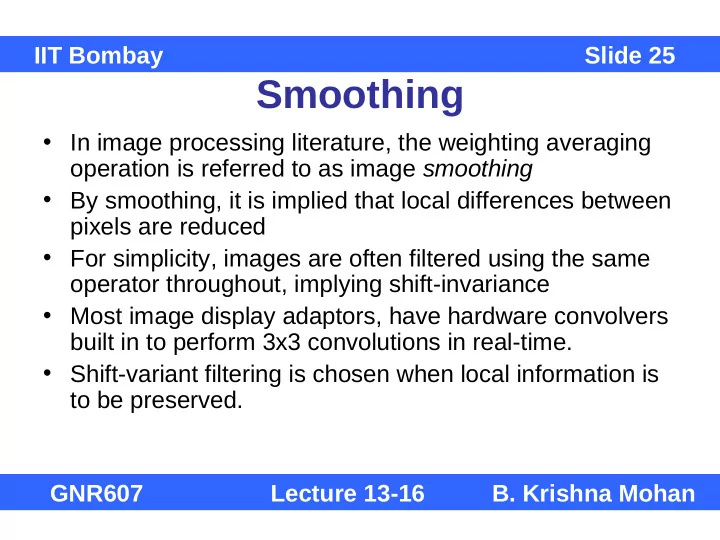

IIT Bombay Slide 25 Smoothing • In image processing literature, the weighting averaging operation is referred to as image smoothing • By smoothing, it is implied that local differences between pixels are reduced • For simplicity, images are often filtered using the same operator throughout, implying shift-invariance • Most image display adaptors, have hardware convolvers built in to perform 3x3 convolutions in real-time. • Shift-variant filtering is chosen when local information is to be preserved. GNR607 Lecture 13-16 B. Krishna Mohan
IIT Bombay Slide 26 Original Image GNR607 Lecture 13-16 B. Krishna Mohan
IIT Bombay Slide 27 3x3 averaging GNR607 Lecture 13-16 B. Krishna Mohan
IIT Bombay Slide 28 Gaussian smoothing • Gaussian filter: linear smoothing • weight matrix 2 2 + 1 r c − ( ) = 2 σ w ( r , c ) ke 2 1 = k ∈ ( r , c ) W , for all where 2 2 + 1 r c − ( ) ∑ 2 e 2 σ ∈ ( r , c ) W W : one or two σ from center GNR607 Lecture 13-16 B. Krishna Mohan
IIT Bombay Slide 28a Gaussian smoothing • Use of Gaussian filter: Specify size of neighborhood size, and given value of σ , determine filter coefficients by varying r,c in the range [–W/2 +W/2] • Alternatively, given value of σ , find the size of the neighbourhood from 3 σ limits • About 99% of the Gaussian distribution is covered within the range mean ± 3 3 σ • r,c vary in the range = [-3 σ + 3 σ ] • For example, if σ = 1, then the range is [-3 3], i.e., the size of neighbourhood is 7x7 GNR607 Lecture 13-16 B. Krishna Mohan
IIT Bombay Slide 28b p(x) Gaussian curve x µ−2σ µ−σ µ µ+σ µ+2σ GNR607 Lecture 13-16 B. Krishna Mohan
IIT Bombay Slide 29 Shift-Variant Filtering • When the filtering operation is required to adapt to the local intensity variations then the filter coefficients should vary according to the position in the image. • Shift-variant filters can preserve the object boundaries better, while smoothing the image • One example is the sigma filter GNR607 Lecture 13-16 B. Krishna Mohan
IIT Bombay Slide 30 Sigma filter • The underlying principle here is to take the subset of pixels in the neighborhood whose gray levels lie within c. σ of the central pixel = + = + k i w l j w = ∑ ∑ g h f − − i j , i j k l , , , i k j l , = − = − k i w l j w • h i,j,k,l = 0 if |f i-j,k=l – f ij | > c. σ ij ; h i,j,k,l = 1 otherwise σ ij is the local standard deviation of the gray levels within the neighborhood centred at pixel (i,j) • To save time, one can also use global std. dev. • c = 1 or 2 depending on the size of neighborhood GNR607 Lecture 13-16 B. Krishna Mohan
IIT Bombay Slide 31 Sigma Filter Algorithm • Consider neighborhood size, and value of c • Find the mean and standard deviation of the pixels within the neighborhood • Find the neighbors of the central pixel whose gray levels are within c. σ of the central pixel’s gray level • Compute the average of the pixels meeting the above criterion • Replace the central pixel’s value by the average • This cannot be replaced by a convolution since the filter response varies for each position in the image GNR607 Lecture 13-16 B. Krishna Mohan
IIT Bombay Slide 31a Comments on Sigma Filter • Degradation of a smoothed image is due to blurring of object boundaries • Here boundaries are better preserved by limiting the smoothing only to a homogeneous subset of pixels in the neighborhood • The selected subset comprises those pixels that have similar intensities • Pixels with very different intensities are excluded by making corresponding weights equal to 0 GNR607 Lecture 13-16 B. Krishna Mohan
IIT Bombay Slide 32 Lee filter Simple Lee filter • g ij = f mean + k.(f ij – f mean ) • k varies between 0 and 2 k = 0, g ij = f mean simple averaging k = 1, g ij = f ij no smoothing at all k = 2, g ij = f ij + (f ij – f mean ) Interpretation of (f ij – f mean ) ??? GNR607 Lecture 13-16 B. Krishna Mohan
IIT Bombay Slide 33 Lee filter a. Original image b. Wallis filter c. K=2 d. K=3 e. K=0.5 f. K=0 GNR607 Lecture 13-16 B. Krishna Mohan
IIT Bombay Slide 34 General form of Lee filter • The general form of Lee filter is given by = + − g f k ( f f ) ij mean ij ij mean • k ij is given by σ 2 ij = k ij σ + σ 2 2 2 f mean v ij • Greater noise, smaller k ij , hence more smoothing GNR607 Lecture 13-16 B. Krishna Mohan
Recommend
More recommend